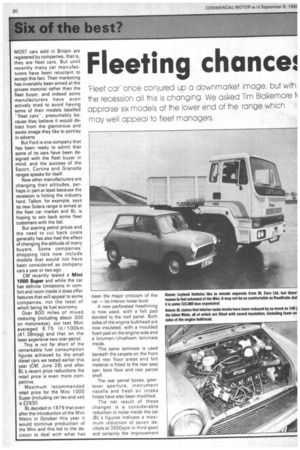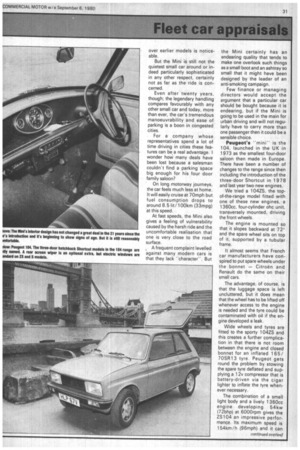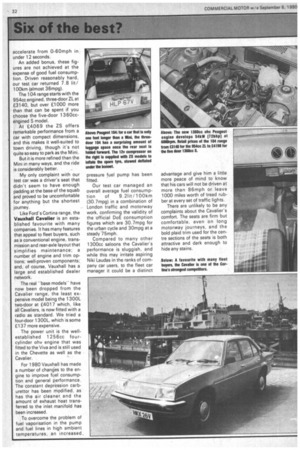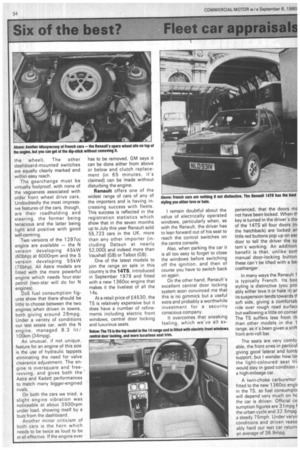Fleeting chancel
Page 32

Page 33

Page 34

Page 35

Page 36

If you've noticed an error in this article please click here to report it so we can fix it.
MOST cars sold in Britain are registered by companies, that is, they are fleet cars. But until recently many car manufacturers have been reluctant to accept this fact. Their marketing has invariably been aimed at the private motorist rather than the fleet buyer, and indeed some manufacturers have even actively tried to avoid having some of their models labelled -fleet cars'', presumably because they believe it would detract from the glamorous and exotic image they like to portray in adverts.
But Ford is one company that has been ready to admit that some of its cars have been designed with the fleet buyer in mind, and the success of the Escort, Cortina and Granada ranges speaks for itself.
Now other manufacturers are changing their attitudes, perhaps in part at least because the recession is hitting the industry hard. Talbot, for example, says its new Solara range is aimed at the fleet car market and BL is hoping to win back some fleet customers with the Ital.
But soaring petrol prices and the need to cut back costs generally has also had the effect of changing the attitude of many buyers. Some companies' shopping lists now include models that would not have been considered as company cars a year or two ago.
CM recently tested a Mini 1000 Super and while the car has definite limitations in comfort and room inside it does offer features that will appeal to some companies, not the least of which being its fuel economy.
Over 800 miles of mixed motoring (including about 300 on motorways), our test Mini averaged 6.75 Lit/ 100km (41.38mpg) and that on the least expensive two-star petrol.
This is not far short of the remarkable fuel consumption figures achieved by the small diesel cars we tested earlier this year (CM, June 28) and after BL's recent price reductions the retail price is even more competitive.
Maximum recommended retail price for the Mini 1000 Super (including car tax and vat) is £2930.
BL decided in 1979 that even after the introduction of the Mini Metro in October this year it would continue production of the Mini and this led to the decision to deal with what has been the major criticism of the car — its interior noise level.
A new perforated headlining is now used, with a felt pad bonded to the roof panel. Both sides of the engine bulkhead are now insulated, with a moulded foam pad on the engine side and a bitumen /chipfoam laminate inside.
This same laminate is used beneath the carpets on the front and rear floor areas and felt material is fitted to the rear seat pan, boot floor and rear parcel shelf.
The rear parcel boxes, gearlever aperture, instrument nacelle and fresh air intake hoses have also been modified.
The net result of these changes is a considerable reduction in noise inside the car (BL's figures indicate a maximum reduction of seven decibels at 3500rpm in third gear) and certainly the improvement over earlier models is noticeable.
But the Mini is still not the quietest small car around or indeed particularly sophisticated in any other respect, certainly not as far as the ride is concerned.
Even after twenty years, though; the legendary handling compares favourably with any other small car and today, more than ever, the car's tremendous manoeuvrability and ease of parking is a boon in congested cities.
For a company whose representatives spend a lot of time driving in cities these features can be.a real advantage. I wonder how many deals have been lost because a salesman couldn't find a parking space big enough for his four door family saloon?
On long motorway journeys, the car feels much less at home. It will easily cruise at 70mph but fuel consumption drops to around 8.5 lit/100km (33mpg) at this speed.
At fast speeds, the Mini also gives a feeling of vulnerability caused by the harsh ride and the uncomfortable realisation that one is very close to the road surface.
A frequent complaint levelled against many modern cars is that they lack "character". But the Mini certainly has an endearing quality that tends to make one overlook such things as a small boot and an ashtray so small that it might have been designed by the leader of an anti-smoking campaign.
Few finance or managing directors would accept the argument that a particular car should be bought because it is endearing, but if the Mini is going to be used in the main for urban driving and will not regularly have to carry more than one passenger then it could be a sensible choice.
Peugeot's "mini" is the 104, launched in the UK in 1973 as the smallest four-door saloon then made in Europe. There have been a number of changes to the range since then including the introduction of the three-door Shortcut in 1978 and last year two new engines.
We tried a 104ZS, the topof-the-range model fitted with one of these new engines, a 1360cc, four-cylinder ohc unit, transversely mounted, driving the front wheels.
The engine is mounted so that it slopes backward at 72' and the spare wheel sits on top of it, supported by a tubular frame.
It almost seems that French car manufacturers have conspired to put spare wheels under the bonnet — Citroen and Renault do the same on their small cars.
The advantage, of course, is that the luggage space is left uncluttered, but it does mean that the wheel has to be lifted off whenever access to the engine is needed and the tyre could be contaminated with oil if the engine developed a leak.
Wide wheels and tyres are fitted to the sporty 104ZS and this creates a further complication in that there is not room between the engine and closed bonnet for an inflated 165 / 70SR13 tyre. Peugeot gets round the problem by stowing the spare tyre deflated and supplying a 12v compressor that is battery-driven via the cigar lighter to inflate the tyre whenever necessary.
The combination of a small light body and a lively 1360cc engine developing 54kw (72bhp) at 6000rpm gives the ZS104 an impressive performance. Its maximum speed is 154km /h (96mph) and it can accelerate from 0-60mph in under 12 seconds.
An added bonus, these figures are not achieved at the expense of good fuel consumption. Driven reasonably hard, our test car returned 7.8 lit! 100km (almost 36mpg).
The 104 range starts with the 954cc engined, three-door ZL at £3140, but over £1000 more than that can be spent if you choose the five-door 1360ccengined S model.
At £4069 the ZS offers remarkable performance from a car with compact dimensions, and this makes it well-suited to town driving, though its not quite so easy to park as the Mini.
But it is more refined than the Mini in many ways, and the ride is considerably better.
My only complaint with our test car was a driver's seat that didn't seem to have enough padding at the base of the squab and proved to be uncomfortable for anything but the shortest journey, Like Ford's Cortina range, the Vauxhall Cavalier is an established favourite with many companies. It has many features that appeal to fleet buyers, such as a conventional engine, transmission and rear-axle layout that simplifies maintenance; a number of engine and trim options; well-proven components; and, of course, Vauxhall has a large and established dealer network.
The real "base models" have now been dropped from the Cavalier range, the least expensive model being the 1300L two-door at £4017 which, like all Cavaliers, is now fitted with a radio as standard. We tried a four-door 1300L, which is some £137 more expensive.
The power unit is the wellestablished 1256cc fourcylinder ohv engine that was fitted to the Viva and is still used in the Chevette as well as the Cavalier.
For 1980 Vauxhall has made a number of chan6es to the engine to improve fuel consumption and general performance. The constant depression carburettor has been modified, as has the air cleaner and the amount of exhaust heat transferred to the inlet manifold has been increased.
To overcome the problem of fuel vaporisation in the pump and fuel lines in high ambient temperatures, an increased, pressure fuel pump has been fitted.
Our test car managed an overall average fuel consump tion of / 100km (30.7mpg) in a combination of London traffic and motorway work, confirming the validity of the official DoE consumption figures which are 30.7mpg for the urban cycle and 30mpg at a steady 75mph.
Compared to many other 1300cc saloons the Cavalier's performance is sluggish, and while this may irritate aspiring Niki Laudas in the ranks of company car users, to the fleet car manager it could be a distinct advantage and give him a little more peace of mind to know that his cars will not be driven at more than 86mph or leave 1000 miles worth of tread rubber at every set of traffic lights.
There are unlikely to be any complaints about the Cavalier's comfort. The seats are firm but comfortable, even on long motorway journeys, and the bold plaid trim used for the centre sections of the seats is both attractive and dark enough to hide any stains.
I particularly liked the large mount of stowage space for dds and ends in the Cavalier — )ere is a tray in front of the earlever and one alongside the and-brake lever, as well as a river's door pocket and a glove ampartment (which could be Jrther improved by making it ickable).
The instrument panel is easy ) read, having bold orangeloured figures and dials on a iatt black background and all le controls are well placed, ith the exception of the clutch ?dal which is too close to the ansmission tunnel and does )t leave enough space for the .iver to rest his left foot.
I also found that the light tion of the diaphragm clutch 3S too fierce, making it unusuy difficult to avoid stalling the
car occasionally in traffic.
There are no surprises in the Cavalier's handling — it has to be pushed really hard to make the rear wheels break away on a corner and then it can easily be corrected. One pleasant surprise is the exceptionally good steering lock which makes it more manoeuvrable than one might expect for a car of its size.
If one compares General Motors' latest European cars, the Opel Kadett and Vauxhall Astra, with the existing Cavalier and Chevette design it looks as though GM's design engineers have said "and now for something completely different' The new 1.3 litre engine is mounted transversely and drives the front wheels and there is independent suspension all round, with MacPherson struts at the front and miniblock coil springs at the rear.
With the Kadett range the same basic body shape is used for saloon, hatchback and estate models, whereas the Vauxhall Astra is available only in hatchback and estate form.
We tried a Kadett LS fivedoor estate and an Astra L five-door hatchback. Both are very impressive cars. In some vehicles it takes only a few minutes for a driver new to the vehicle to be favourably impressed and the new models from GM are no exception.
There is no need to fumble experimentally with a multitude of stalks sprouting from the steering column for there are just two, one each side, and it is immediately obvious which functions they control (and they both can be easily reached without taking your hands from the wheel). The other dashboard-mounted switches are equally clearly marked and within easy reach.
The gearchange must be virtually foolproof, with none of the vagueness associated with older front wheel drive cars. Undoubtedly the most impress ive features of the cars, though, are their roadholding and steering, the former being tenacious and the latter being light and positive with good self-centring.
Two versions of the 1297cc engine are available — the N version developing 45kW (60bhp) at 6000rpm and the S version developing 55kW (75bhp). All Astra models are fitted with the more powerful engine which needs four-star petrol (two-star will do for N engines).
DoE fuel consumption figures show that there should be little to choose between the two engines.when driven in towns, both giving around 29mpg.
Under a variety of conditions our test estate car, with the N engine, managed 8.3 lit 100km (34mpg).
An unusual, if not unique, feature for an engine of this size is the use of hydraulic tappets eliminating the need for valve clearance adjustment. The engine is oversquare and free revving, and gives both the Astra and Kadett performances to match many bigger-engined rivals.
On both the cars we tried, a slight engine vibration was noticeable at about 3500rpm under load, showing itself by a buzz from the dashboard.
Another minor criticism of both cars is the horn which needs to be twice as loud to be at all effective If the engine ever has to be removed, GM says it can be done either from above or below and clutch replacement (in 65 minutes, it's claimed) can be made without disturbing the engine.
Renault offers one of the widest range of cars of any of the importers and is having increasing success with fleets. This success is reflected in the registration statistics which show that in the seven months up to July this year Renault sold 55,723 cars in the UK, more than any other importer (including Datsun at nearly 52,000) and indeed more than Vauxhall (GB) or Talbot (GB).
One of the latest models to join the range on sale in this country is the 14TS, introduced in September 1979 and fitted with a new 1360cc engine that makes it the liveliest of all the 14s.
At a retail price of £4530, the TS is relatively expensive but it does have a number of refinements including electric front windows, central door locking and luxurious seats. I remain doubtful about the value of electrically operated windows, particularly when, as with the Renault, the driver has to lean forward out of his seat to reach the control switches on the centre console.
Also, when parking the car it is all too easy to forget to close the windows before switching off the ignition, and then of course you have to switch back on again.
On the other hand, Renault's excellent central door locking system soon convinced me that this is no gimmick but a useful extra and probably a worthwhile investment for a security conscious company.
It overcomes that sneaking feeling, which we've all ex perienced, that the doors me not have been locked. When th key is turned in the driver's do( of the 14TS all four doors (ni the hatchback) are locked an little red buttons pop up on eac door to tell the driver the sy tern's working. An addition, benefit is that, unlike son' manual door-locking button these can't be lifted with a bei coathanger.
In many ways the Renault 1 is typically French. Its boc styling is distinctive (you pro! ably either love it or hate it) ar its suspension tends towards th soft side, giving a comfortab ride over rough road surfac( but wallowing a little on corner The TS suffers less from th than other models in the 1 range, as it's been given a stiff front anti-roll bar.
The seats are very comfo able, the front ones in particul giving good lateral and lumb support, but I wonder how lor the light-coloured seat tri would stay in good condition ( a high-mileage car, A twin-choke carburettor fitted to the new 1360cc engii in the TS, so fuel consumpti( will depend very much on hc the car is driven. Official co sumption figures are 31mpg f the urban cycle and 32.5mpg a steady 75mph. Under varyir conditions and driven reaso ably hard our test car return an average of 36.9mpg.




































































































































